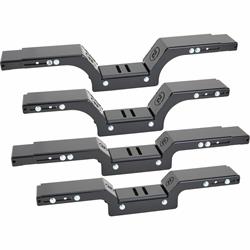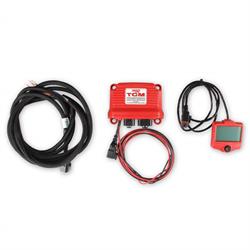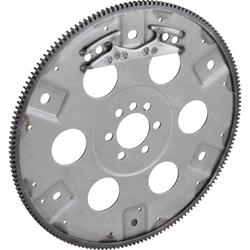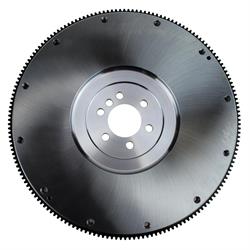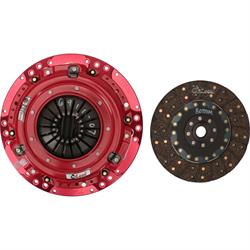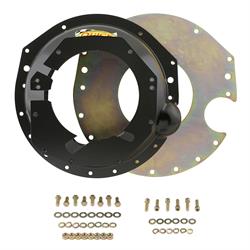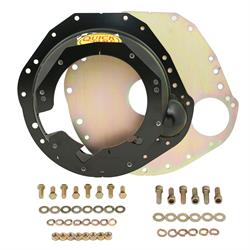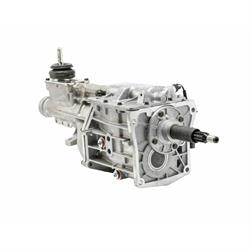Transmission Interchange List Chevy, Ford, Mopar V8 Compatibility
Transmission Compatibility | Can You Put Any Transmission on Any Engine?
While the traditional engine swap gets the lion’s share of the spotlight, what many don’t consider is that with that engine swap often entails a transmission swap as well. Depending on the chassis and what original parts may still be attached to it, a transmission swap is frequently mandatory. Swapping your Model A’s flathead four for a small block Chevy, you’re most certainly not going to retain the unsynchronized three speed manual behind your swapped in 350 small block. Most likely you’ll want to either bolt up a Turbo 350, a modern overdrive automatic, or possibly even a manual transmission with overdrive depending on your cruising plans. Knowing what interchangeable transmission you can mate to your swapped engine (and to the chassis as well) will go a long way in helping your project be successful and not become a piece of garage art holding the floor down. Remember, the best engine transmission combo is often the one you already have lying around and just need an adapter or the right bellhousing to mate the two together.
Consider things like bell housing bolt pattern (will an adapter be required?), or if converting from an automatic to a manual transmission the additional components required for the swap such as clutch, pressure plate, and flywheel (and a way to actuate the clutch). On modern automatic overdrive transmissions many require a standalone transmission controller (unless the transmission is supported by the engine swap’s EFI system). Lastly, most any transmission swap will require a swap specific crossmember to bolt the transmission in. For those cases where one isn’t manufactured for said swap then a universal transmission crossmember is a great solution for these instances. Our TorqLink™ fabricated universal crossmember is available in two different adjustable widths and with drops between 1.5 and 4.5 inches. Read these tips for swapping your engine and transmission before you start your project as well.
Transmission Interchange Chart
Our transmission interchange chart, showing the most popular engine and transmission combinations, will be helpful in determining what transmission you can run behind your engine.
Compatible Transmissions for Chevy Engines
When it comes to the infamous small block Chevy or even the modern day LS V8 from GM, bolting up a GM-based transmission often requires nothing more than the correct flexplate or flywheel, or an adapter to use a specific factory-spec flexplate or flywheel, as shown in our transmission interchange list. This makes things relatively easy going and keeps your ride “all GM” if that means something to you. There are numerous GM-based transmissions to choose from, including aftermarket transmissions like the T56 transmission for sale (known as the Tremec Magnum/TR6060 today and based off the original T56 six-speed manual transmission) that can be used behind your SBC engine. Whether it is a low-budget cruiser and you’re looking for a basic Turbo 350 3-speed automatic to add a higher stall TH350 torque converter to, you’re building a period piece and need a classic Muncie 4-speed, or you’re looking for an electronically controlled modern automatic overdrive for your long haul ride, these transmissions are the simple choice here due to their engine to transmission compatibility.
Transmissions for Chevy Small Block (SBC) Engines
SBC engines pair well with GM’s classic transmissions. Automatics like the TH350, TH400, and 700R4 from B&M Transmission are commonly used. For manual builds, the T5 and Muncie 4-speed are top choices.
- TH350 and TH400 3-Speed Automatics – Strong automatics
- 700R4 4-Speed Automatic – Adds overdrive for cruising
- T5 5-Speed Manual – Lightweight builds
- Muncie 4-Speed Manual – For classic cars
Transmissions for Chevy Big Block (BBC) Engines
Big Block engines like the 454 big block need tough transmissions. The TH400 and 4L80E automatics are durable options. Manual choices include the T56/Magnum series and Muncie 4-speed.
- TH400 3-Speed Automatic – For high-power builds
- 4L80E 4-Speed Automatic – Overdrive and strength
- Muncie 4-Speed Manual – For classic cars
- T56 6-Speed Manual – Manual performance
Transmissions for Chevy LS Engines
LS engines work with many automatic and manual transmissions. Popular automatics include the 4L60E, 4L80E, TH350, and TH400 for their strength. For manual setups, the T56 is often chosen for performance manual LS builds.
- 4L60E 4-Speed Automatic – Great for street use
- 4L80E 4-Speed Automatic – Handles more power
- T56 6-Speed Manual – Performance-focused
Learn more about SBC/BBC flexplates in our SBC flexplate guide, as well as LS flexplate differences elsewhere in our Toolbox to educate yourself on bolt patterns, tooth counts, swap needs, and more.
Will A 4L80E Bolt Up to A 5.3?
The 4L80E is a popular 4-speed automatic overdrive that debuted in GM trucks behind their big block and diesel engines back in the early 1990s. This robust automatic is a popular swap option behind the LS series of V8s and thanks to the LS and small block/big block Chevy engine blocks sharing compatible bellhousing bolt patterns the 4L80E is a direct bolt up to the LS engine. You will however need to address the crankshaft to torque converter spacing using a compatible 6-bolt flexplate, flexplate spacer, or a custom torque converter.
Additionally, you will need an EFI system that includes transmission controls or a standalone transmission controller and some sort of universal or swap transmission crossmember. Lastly, depending on your vehicle, your driveshaft will most likely require shortening and the use of the 4L80E’s 32 spline driveshaft yoke.
Will A 4L80E Bolt Up to A 350?
Again, the 4L80E is a direct fit behind the small block Chevy thanks to GM’s forward thinking on its bellhousing bolt pattern usage across small block AND big block engine families making for many interchangeable transmission options. So, mounting your 4L80E salvage yard find is nothing more than bolting the trans to your 350 block. However, much like the LS question above, ensuring your 4L80E’s torque converter to 350 flexplate connection is correct may take a few additional pieces on your auto transmission parts list. For instance, the 350 can be had in one piece or two piece rear main seal, and this affects the type of flexplate needed. We offer flexplates for both one piece and two piece rear main seal applications that use three of the six mounting points found on the 4L80E torque converter (or they can be drilled to accept all six).
Additionally, you will need an EFI system that includes transmission controls or a standalone transmission controller and some sort of universal or swap transmission crossmember. Our SoloSwap™ 4L80E swap tool is a terrific way to verify chassis fitment without damage to your actual transmission. Lastly, depending on your vehicle, your driveshaft will most likely require shortening and the use of the 4L80E’s 32 spline driveshaft yoke.
Will A T56 Bolt Up To a 5.3?
The classic Tremec T56 found in the Viper, Mustang Cobra, and other OEM applications, is a popular 6-speed manual with double overdrive used in many swaps. Though sold now as the Tremec Magnum in the aftermarket and referred to as the TR6060 in OEM applications like the Camaro ZL1, Cadillac CTS-V, Challenger Hellcat, and others, this 6-speed uses a bolt on bellhousing, allowing it to be attached to a myriad of engine applications simply by selecting the proper bellhousing and the right manual transmission parts. In the case of the 5.3 LS the typical LS-spec bellhousing makes the installation of a T56/Magnum series transmission to a 5.3 (or other LS) a direct fit scenario. You can find compatible models such as the Quick Time bell housing and the Lakewood bellhousing for just about any engine and transmission combination you can think of as well.
Of course, you’ll need supporting components like a clutch and flywheel along with a way to hydraulicly actuate your clutch. Some sort of universal or swap transmission crossmember will be required for most applications. Lastly, depending on your vehicle, your driveshaft will most likely require shortening and the use of the Tremec spec 31 spline driveshaft yoke. Our SoloSwap™ T56 mock up transmission and bellhousing are both great tools to confirm chassis fitment for your T56 swap project as well.
Will A T56 Bolt Up to A 350?
While popular behind the typical LS swap, the T56 (or newer Magnum series 6-speed) can certainly be mounted behind the classic small block Chevy 350 V8 provided the correct T56 bellhousing is utilized, which will also work for big block Chevy applications as well. Much like the LS application, once you have the correct bellhousing for your engine it is simply a matter of ordering the proper clutch and flywheel. In the case of the SBC, you must choose between the pre-1986 two piece rear main seal flywheel and the newer 1986 and up one piece rear main seal flywheel.
Since most T56/Magnum/TR6060 6-speed bellhousings are designed for hydraulic clutch actuation, you will need a way to hydraulically actuate your clutch behind your small block Chevy. Some sort of universal or swap transmission crossmember will be required as well, just like we explained in the 5.3 LS section above. Lastly, depending on your vehicle, your driveshaft will most likely require shortening and the use of the Tremec spec 31 spline driveshaft yoke.
Compatible Transmissions for Ford Engines
When considering transmission upgrades for the Blue Oval faithful, things can be a bit trickier since different Ford bell housings were used with different bolt patterns between engine families. Therefore, when considering are transmissions interchangeable between small block and big block Ford engines, the answer is often a different bellhousing must be used, or some sort of bolt on bell housing adapter if you’re going to “cross pollinate” different transmissions and engines. So, it is possible, but it can add additional cost, complexity, and labor to the swap in some, but not all cases. For example, adding a C4 3-speed automatic or the popular T-5 5-speed manual behind a small block Ford is 100 percent a bolt on procedure as our transmission interchange list proves.
However, if you’re looking to add a 4-speed automatic overdrive transmission to your 429 or 460 big block Ford, then you’re going to either use an adapter plate, a custom built transmission with an aftermarket bellhousing, or the direct fit E4OD which requires a standalone transmission controller. The same can be said for the modern overhead cam engines like the Modular and Coyote engines. Direct fit transmissions like the 6R80 and newer 10-speed automatic bolt right up but will require electronics to control. Older transmissions like the AOD, C4, or aftermarket manuals like the Tremec TKX 5-speed and Magnum 6-speed models simply require the correct bellhousing. See our transmission compatibility chart above for what transmissions are compatible with your Ford engine choice.
Transmissions For Small Block Ford Engines
The venerable small block Ford has a large cross section of transmission options that are direct fit and provide few obstacles to installation. You can easily use the C4 automatic for cruising or even drag racing, while the AOD provides an overdrive gear for those racking up the miles. Of course, manual transmissions are popular behind the small block as well.
- C4 3-Speed Automatic – Compact and reliable
- AOD 4-Speed Automatic – Adds overdrive for highway driving
- T-5 5-Speed Manual – Great for mild performance builds
- TKX 5-Speed Manual– Stronger manual option for high-power builds
Transmissions for Ford 460 (Big Block) Engines
Ford’s 385 Series big blocks, factory produced in 429 and 460 cubic inch displacements, are known for their torque output and are still popular today in hot rod, muscle car, and truck builds. Adding an overdrive transmission to one usually requires the correct bellhousing, but some transmissions are a direct fit like the classic C6 or the modern E4OD.
- C6 3-Speed Automatic – Built for high torque
- E4OD 4-Speed Automatic – Adds overdrive but requires electronic controller
- Toploader 4-Speed Manual – Classic non-OD manual for big-block power
- Tremec TKX 5-Speed Manual – Strong manual option
Transmissions for Ford Coyote Engines
The DOHC 32-valve 5.0L Ford Coyote V8, now entering its 4th generation in the 2024 Mustang, has been a popular engine swap for Ford fans since the engine debuted in the 2011 Mustang and F-150. Due to the modular bellhousing pattern, it will require an adapter or specific bellhousing to run older transmissions like the C4, AOD, etc. but the good news is that modern automatics and manuals found behind the Modular engine family are direct fits (though the autos will require standalone shift controls).
- 6R80 6-Speed Automatic – Strong and reliable
- 10R80 10-Speed Automatic – More gears for efficiency
- Tremec Magnum 6-Speed Manual – High-performance manual
Learn more about SBF/BBF flexplates, including flex plate diagrams elsewhere in our Toolbox to educate yourself on bolt patterns, tooth counts, swap needs, and more.
Will A T56 Bolt Up to A 302?
The Tremec T56 was used by Ford in the 2003-2004 Mustang SVT Cobra model and later as the refined/upgraded Tremec TR-6060 in the 2007-2014 Shelby GT500 Mustang models. Both versions of the Tremec 6-speed will bolt up to your small block Ford quite easily using the correct bellhousing, clutch, and flywheel. For bellhousing note that there are different versions for use with the standard T56 and the GM and Viper-spec T56 models.
You will also need to determine your small block Ford’s external balance needs as well to choose the correct flywheel. Pre-1981 302ci small block Fords use a 28 oz balance flywheel and 1981 and later 302 engine uses a 50 oz balance flywheel. 351W were all 28 oz. If you are unsure check with your engine builder, as the blocks can use either balance if all the parts (damper, crank, flywheel) are matched. Note too that most stroker kits, like the popular 331 and 347 kits use the 28 oz balance. The good news is that the clutch doesn’t care about engine balance, so just grab a clutch disc with the correct spline count for your T56. Most T56 are 26 splines, so something like this RAM Powergrip will work nicely in a small block Ford swap.
Since most T56/Magnum/TR6060 6-speed bellhousings are designed for hydraulic clutch actuation, you will need a way to hydraulically actuate your clutch behind your small block Ford. Some sort of universal or swap transmission crossmember will be required as well. Lastly, depending on your vehicle, your driveshaft will most likely require shortening and the use of the Tremec spec 31 spline driveshaft yoke.
Compatible Transmissions for Chrysler Engines
Those that are passionate about all things Mopar have a broad choice of original automatic and manual transmissions to choose from to give their rides the proper motivation. Aftermarket manual transmissions are of course popular as well to provide that modern overdrive you can hide under an OE console and row via a modified or aftermarket pistol grip-style shifter. The 318 and 340 small blocks can easily accept the A727 3-speed automatic, A904 3-speed automatic, A833 4-speed manual, and the T-5 5-speed manual. For the 440 Big Block, popular options include the A727 3-speed automatic, A833 4-speed manual, A518 4-speed automatic with overdrive, and the Tremec TKX 5-speed manual.
Modern Gen III Hemi engines are compatible with transmissions like the A727 3-speed automatic, A904 3-speed automatic, and the A833 4-speed manual thanks to a shared bellhousing pattern (minus one bolt). Though you’ll have to use a special flexplate, flywheel, or converter to make it happen. Modern automatic transmissions like the NAG1 5-speed and ZF 8HP70 8-speed are direct fit, but you’ll need a way to control the electronics for shifting. Manual aftermarket options like the Tremec T56/Magnum/TR-6060 6-speed manual family simply take the proper bellhousing and clutch.
Transmissions for Chrysler 318 Small Block Engines
The 318 was Chrysler’s bread and butter V8 and as such is limited to how much power it can make, allowing light duty transmissions to work easily without breaking.
- A904 3-Speed Automatic – Light and efficient
- A727 3-Speed Automatic – Stronger for more power
- A833 4-Speed Manual – Classic manual
- T-5 5-Speed Manual – Popular for modern swaps
Transmissions for Chrysler 340 Small Block Engines The 340 not only adds more displacement, but more power, however, Chrysler’s line of classic automatics can still handle the work load.
- A727 3-Speed Automatic – Durable for small blocks
- A518 4-Speed Automatic – Adds overdrive without the need for electronics
- A833 4-Speed Manual – Classic choice for manuals
- Tremec TKX 5-Speed Manual – Lightweight and popular for swaps
Transmissions for Chrysler 440 Big Block Engines
Moving into big block territory means more torque, but these popular Chrysler transmissions can all be built to handle the additional torque output of the 440 big block.
- A727 3-Speed Automatic – Strong and reliable
- A833 4-Speed Manual – Classic manual option
- A518 4-Speed Automatic – Adds overdrive but requires swap bellhousing
- Tremec TKX 5-Speed Manual – A modern manual with overdrive
Transmissions for Gen III Hemi Engines
The Gen III Hemi came from the factory with some particularly good automatic and manual transmission options. If you can score your Gen III Hemi swap engine with its transmission, you’re one step closer, otherwise look to these options to mate to your Gen III Hemi swap.
- NAG1 5-Speed Automatic – Strong, common in newer Mopars, requires shift controller
- ZF 8HP70 8-Speed Automatic – Smooth and efficient, requires shift controller
- Tremec T56/Magnum/TR-6060 Manual – High-performance 6-speed
Learn more in our Mopar flexplate guide elsewhere in our Toolbox to educate yourself on bolt patterns, tooth counts, swap needs, and more.
Mopar Engine to Transmission Adapters
As popular as the Tremec T56 swap is across all brands, the Mopar faithful have it the hardest when it comes to the correct bits to achieve said transmission swap. While Quick Time offers the correct bellhousings for the T56/Magnum/TR-6060 series transmissions to small block Mopar, big block Mopar, and Gen III Hemi to physically connect the engine and transmission, you’ll need flywheel, clutch, and hydraulic components to complete the full swap. Small block and big block Mopar use one flywheel, while the modern Hemi has its own flywheel needs. You’ll need a 26-spline clutch of course for the T56 6-speed, but thankfully the small block, big block, and modern Hemi engines all use the same clutch for this application.
- Quick Time RM-8074 Bellhousing: Fits Small Block Mopar to T56 6-Speed Transmission
- Quick Time RM-8073 Bellhousing: Fits Big Block Mopar to T56 6-Speed Transmission
- Quick Time RM-8077 Bellhousing: Fits 5.7/6.1L Gen III Hemi to T56 6-Speed Transmission
As we’ve mentioned previously, you will need a way to hydraulically actuate your clutch behind your Mopar’s engine with most manual transmission swaps, especially any modern 5- or 6-speed offering. Some sort of universal transmission crossmember, such as our TorqLink™ adjustable width crossmember will be required as well.
Engine to Transmission Compatibility
The popularity of engine swaps across classic muscle cars, trucks, and of course hot rods and kit car builds often have people wondering “What engines fit my car?” Well, there are some obvious answers like installing anything that came as a factory option will be relatively easy using factory-style mounts, exhaust, etc. Swapping a modern engine into a classic is common these days usually by using swap mounts and header kits, while other engines will take considerable fabrication to fit, but will really wow the cruise in crowd when the hood goes up. Mixing brands, like adding a big block Chevy to a ’40 Ford means knowing engine dimensions and weights. To that end, we have created an engine swap compatibility checker on common engine swap dimensions that may be a helpful resource if you’re going to swap something a little “left of center” into your project. Once you’ve confirmed the engine will physically fit, then you can begin your homework on mounting solutions, what transmission to fit to your swap engine using our transmission compatibility chart above, and more to get your project off the jack stands and on the road in a timely manner.
Technical contributor: Jerad Flemming








